Comprehensive Report on Partnership in Health and Social Care (L5)
VerifiedAdded on 2020/10/05
|15
|4334
|202
Report
AI Summary
This report delves into the critical aspects of partnership working within the health and social care sectors. It begins by outlining the philosophies underpinning such collaborations, emphasizing empowerment, respect, power-sharing, and informed choices, and their impact on service users and the community. The report then explores the dynamics of partnership relationships, identifying key stakeholders like care staff, service users, medical professionals, and support workers, and their respective roles. Furthermore, it examines different partnership models, including unified, coalition, and hybrid models, highlighting their structures and objectives. A significant portion of the report focuses on current legislation and policies such as the Mental Capacity Act 2005, Children Act 1989, and the Disability Discrimination Act 2005, and their influence on collaborative practices. It addresses how differences in departmental goals and working practices can hinder effective collaboration and discusses potential barriers. Finally, it explores strategies for improving partnership outcomes, aiming to enhance service delivery for users, professionals, and organizations involved.

Working in
Partnership in Health
and Social Care (L5)
Partnership in Health
and Social Care (L5)
Paraphrase This Document
Need a fresh take? Get an instant paraphrase of this document with our AI Paraphraser
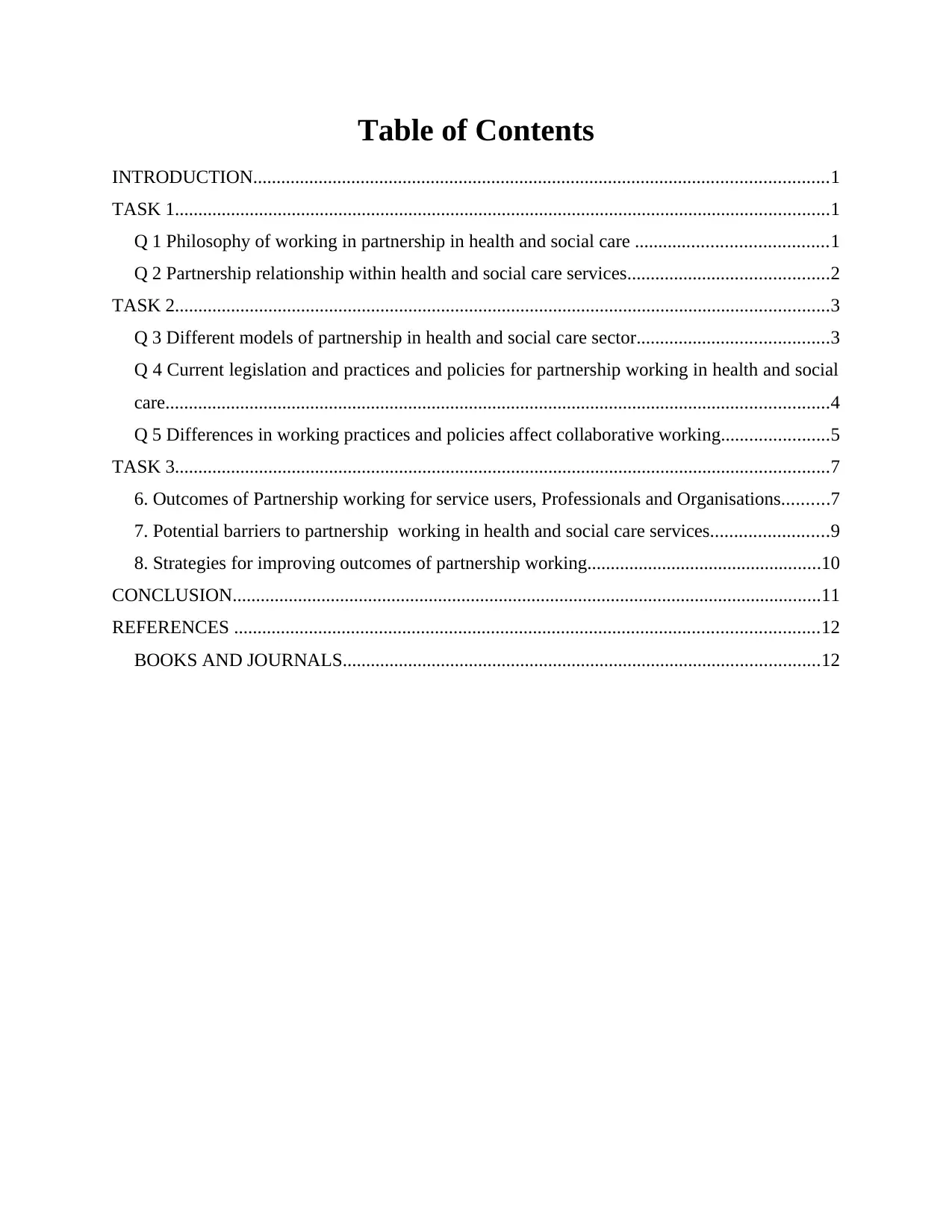
Table of Contents
INTRODUCTION...........................................................................................................................1
TASK 1............................................................................................................................................1
Q 1 Philosophy of working in partnership in health and social care .........................................1
Q 2 Partnership relationship within health and social care services...........................................2
TASK 2............................................................................................................................................3
Q 3 Different models of partnership in health and social care sector.........................................3
Q 4 Current legislation and practices and policies for partnership working in health and social
care..............................................................................................................................................4
Q 5 Differences in working practices and policies affect collaborative working.......................5
TASK 3............................................................................................................................................7
6. Outcomes of Partnership working for service users, Professionals and Organisations..........7
7. Potential barriers to partnership working in health and social care services.........................9
8. Strategies for improving outcomes of partnership working..................................................10
CONCLUSION..............................................................................................................................11
REFERENCES .............................................................................................................................12
BOOKS AND JOURNALS......................................................................................................12
INTRODUCTION...........................................................................................................................1
TASK 1............................................................................................................................................1
Q 1 Philosophy of working in partnership in health and social care .........................................1
Q 2 Partnership relationship within health and social care services...........................................2
TASK 2............................................................................................................................................3
Q 3 Different models of partnership in health and social care sector.........................................3
Q 4 Current legislation and practices and policies for partnership working in health and social
care..............................................................................................................................................4
Q 5 Differences in working practices and policies affect collaborative working.......................5
TASK 3............................................................................................................................................7
6. Outcomes of Partnership working for service users, Professionals and Organisations..........7
7. Potential barriers to partnership working in health and social care services.........................9
8. Strategies for improving outcomes of partnership working..................................................10
CONCLUSION..............................................................................................................................11
REFERENCES .............................................................................................................................12
BOOKS AND JOURNALS......................................................................................................12
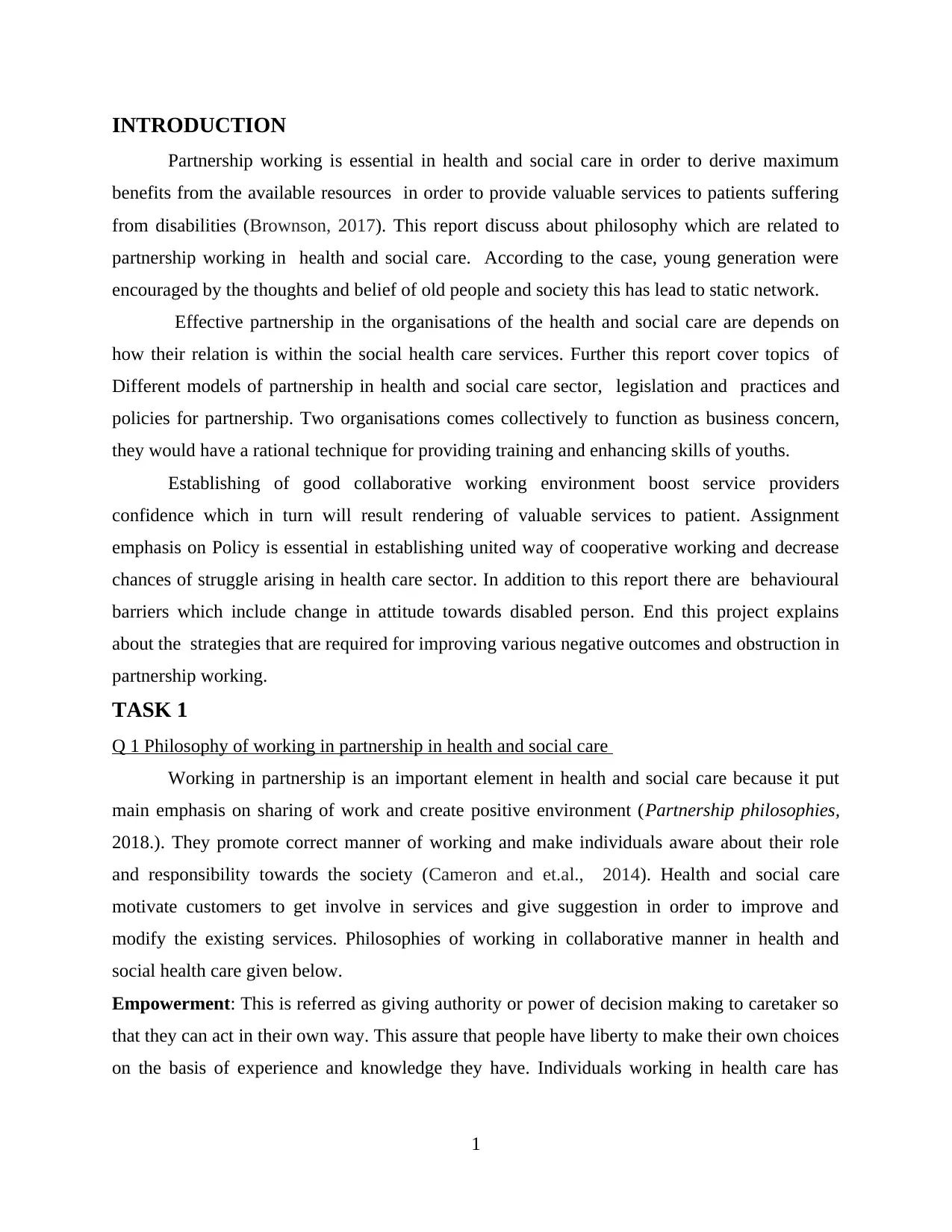
INTRODUCTION
Partnership working is essential in health and social care in order to derive maximum
benefits from the available resources in order to provide valuable services to patients suffering
from disabilities (Brownson, 2017). This report discuss about philosophy which are related to
partnership working in health and social care. According to the case, young generation were
encouraged by the thoughts and belief of old people and society this has lead to static network.
Effective partnership in the organisations of the health and social care are depends on
how their relation is within the social health care services. Further this report cover topics of
Different models of partnership in health and social care sector, legislation and practices and
policies for partnership. Two organisations comes collectively to function as business concern,
they would have a rational technique for providing training and enhancing skills of youths.
Establishing of good collaborative working environment boost service providers
confidence which in turn will result rendering of valuable services to patient. Assignment
emphasis on Policy is essential in establishing united way of cooperative working and decrease
chances of struggle arising in health care sector. In addition to this report there are behavioural
barriers which include change in attitude towards disabled person. End this project explains
about the strategies that are required for improving various negative outcomes and obstruction in
partnership working.
TASK 1
Q 1 Philosophy of working in partnership in health and social care
Working in partnership is an important element in health and social care because it put
main emphasis on sharing of work and create positive environment (Partnership philosophies,
2018.). They promote correct manner of working and make individuals aware about their role
and responsibility towards the society (Cameron and et.al., 2014). Health and social care
motivate customers to get involve in services and give suggestion in order to improve and
modify the existing services. Philosophies of working in collaborative manner in health and
social health care given below.
Empowerment: This is referred as giving authority or power of decision making to caretaker so
that they can act in their own way. This assure that people have liberty to make their own choices
on the basis of experience and knowledge they have. Individuals working in health care has
1
Partnership working is essential in health and social care in order to derive maximum
benefits from the available resources in order to provide valuable services to patients suffering
from disabilities (Brownson, 2017). This report discuss about philosophy which are related to
partnership working in health and social care. According to the case, young generation were
encouraged by the thoughts and belief of old people and society this has lead to static network.
Effective partnership in the organisations of the health and social care are depends on
how their relation is within the social health care services. Further this report cover topics of
Different models of partnership in health and social care sector, legislation and practices and
policies for partnership. Two organisations comes collectively to function as business concern,
they would have a rational technique for providing training and enhancing skills of youths.
Establishing of good collaborative working environment boost service providers
confidence which in turn will result rendering of valuable services to patient. Assignment
emphasis on Policy is essential in establishing united way of cooperative working and decrease
chances of struggle arising in health care sector. In addition to this report there are behavioural
barriers which include change in attitude towards disabled person. End this project explains
about the strategies that are required for improving various negative outcomes and obstruction in
partnership working.
TASK 1
Q 1 Philosophy of working in partnership in health and social care
Working in partnership is an important element in health and social care because it put
main emphasis on sharing of work and create positive environment (Partnership philosophies,
2018.). They promote correct manner of working and make individuals aware about their role
and responsibility towards the society (Cameron and et.al., 2014). Health and social care
motivate customers to get involve in services and give suggestion in order to improve and
modify the existing services. Philosophies of working in collaborative manner in health and
social health care given below.
Empowerment: This is referred as giving authority or power of decision making to caretaker so
that they can act in their own way. This assure that people have liberty to make their own choices
on the basis of experience and knowledge they have. Individuals working in health care has
1
⊘ This is a preview!⊘
Do you want full access?
Subscribe today to unlock all pages.

Trusted by 1+ million students worldwide
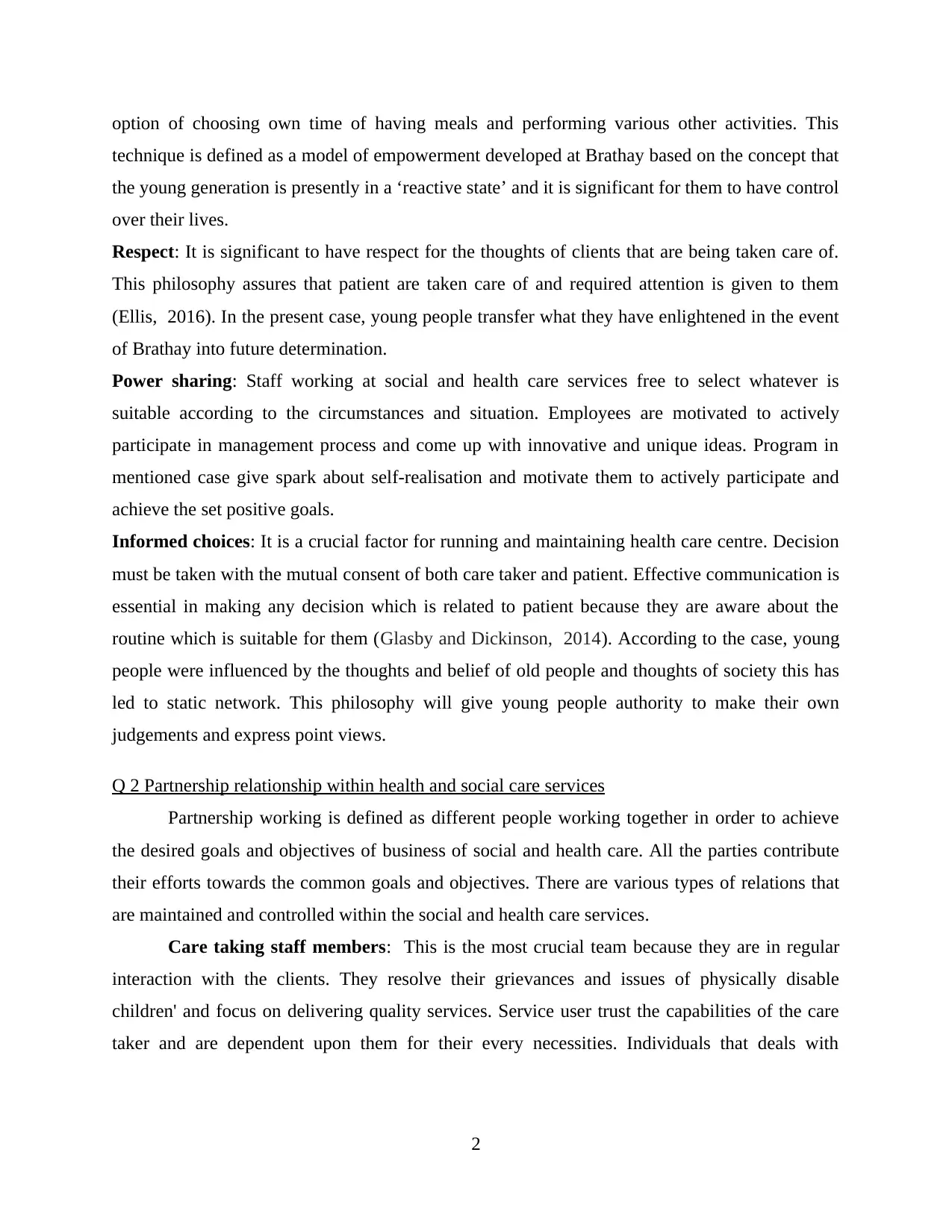
option of choosing own time of having meals and performing various other activities. This
technique is defined as a model of empowerment developed at Brathay based on the concept that
the young generation is presently in a ‘reactive state’ and it is significant for them to have control
over their lives.
Respect: It is significant to have respect for the thoughts of clients that are being taken care of.
This philosophy assures that patient are taken care of and required attention is given to them
(Ellis, 2016). In the present case, young people transfer what they have enlightened in the event
of Brathay into future determination.
Power sharing: Staff working at social and health care services free to select whatever is
suitable according to the circumstances and situation. Employees are motivated to actively
participate in management process and come up with innovative and unique ideas. Program in
mentioned case give spark about self-realisation and motivate them to actively participate and
achieve the set positive goals.
Informed choices: It is a crucial factor for running and maintaining health care centre. Decision
must be taken with the mutual consent of both care taker and patient. Effective communication is
essential in making any decision which is related to patient because they are aware about the
routine which is suitable for them (Glasby and Dickinson, 2014). According to the case, young
people were influenced by the thoughts and belief of old people and thoughts of society this has
led to static network. This philosophy will give young people authority to make their own
judgements and express point views.
Q 2 Partnership relationship within health and social care services
Partnership working is defined as different people working together in order to achieve
the desired goals and objectives of business of social and health care. All the parties contribute
their efforts towards the common goals and objectives. There are various types of relations that
are maintained and controlled within the social and health care services.
Care taking staff members: This is the most crucial team because they are in regular
interaction with the clients. They resolve their grievances and issues of physically disable
children' and focus on delivering quality services. Service user trust the capabilities of the care
taker and are dependent upon them for their every necessities. Individuals that deals with
2
technique is defined as a model of empowerment developed at Brathay based on the concept that
the young generation is presently in a ‘reactive state’ and it is significant for them to have control
over their lives.
Respect: It is significant to have respect for the thoughts of clients that are being taken care of.
This philosophy assures that patient are taken care of and required attention is given to them
(Ellis, 2016). In the present case, young people transfer what they have enlightened in the event
of Brathay into future determination.
Power sharing: Staff working at social and health care services free to select whatever is
suitable according to the circumstances and situation. Employees are motivated to actively
participate in management process and come up with innovative and unique ideas. Program in
mentioned case give spark about self-realisation and motivate them to actively participate and
achieve the set positive goals.
Informed choices: It is a crucial factor for running and maintaining health care centre. Decision
must be taken with the mutual consent of both care taker and patient. Effective communication is
essential in making any decision which is related to patient because they are aware about the
routine which is suitable for them (Glasby and Dickinson, 2014). According to the case, young
people were influenced by the thoughts and belief of old people and thoughts of society this has
led to static network. This philosophy will give young people authority to make their own
judgements and express point views.
Q 2 Partnership relationship within health and social care services
Partnership working is defined as different people working together in order to achieve
the desired goals and objectives of business of social and health care. All the parties contribute
their efforts towards the common goals and objectives. There are various types of relations that
are maintained and controlled within the social and health care services.
Care taking staff members: This is the most crucial team because they are in regular
interaction with the clients. They resolve their grievances and issues of physically disable
children' and focus on delivering quality services. Service user trust the capabilities of the care
taker and are dependent upon them for their every necessities. Individuals that deals with
2
Paraphrase This Document
Need a fresh take? Get an instant paraphrase of this document with our AI Paraphraser
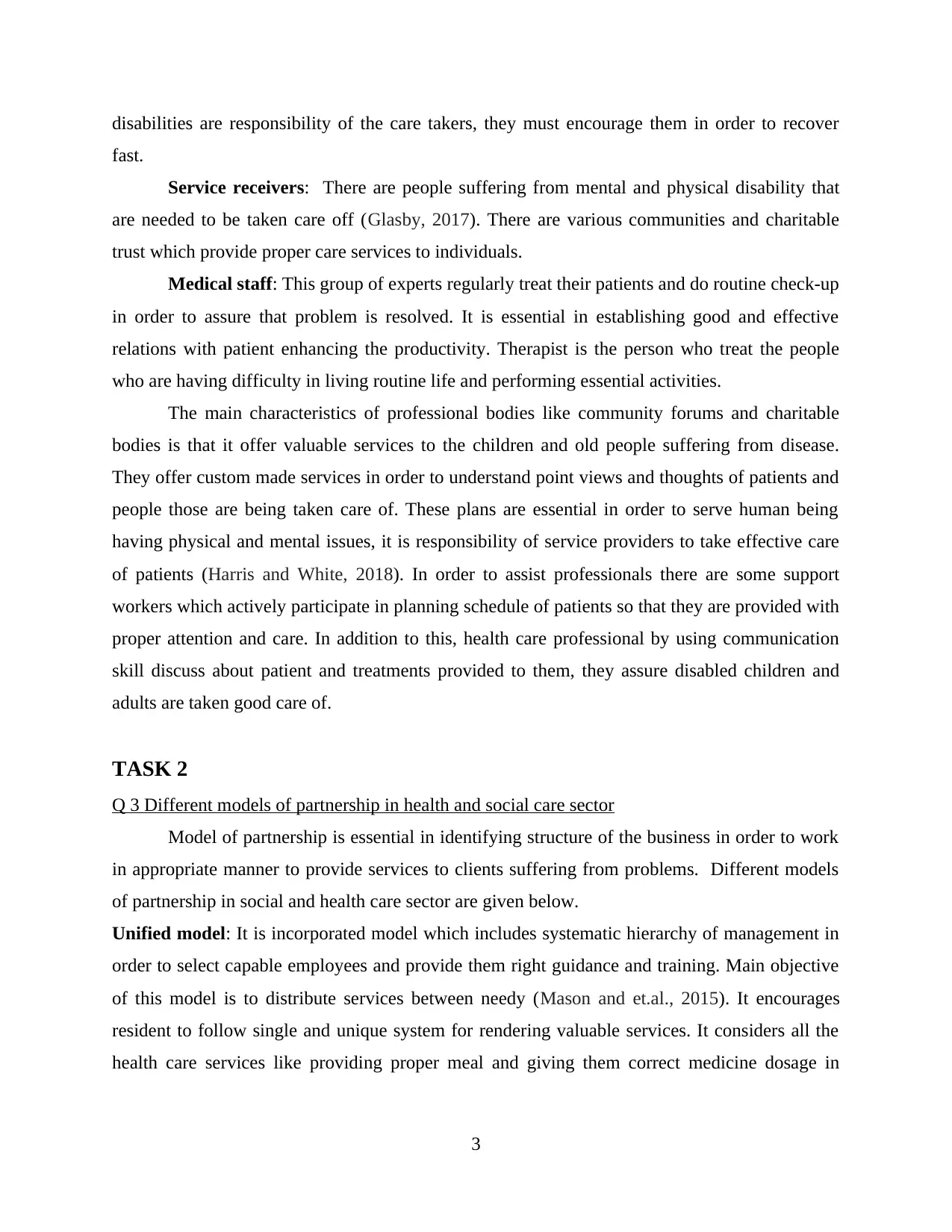
disabilities are responsibility of the care takers, they must encourage them in order to recover
fast.
Service receivers: There are people suffering from mental and physical disability that
are needed to be taken care off (Glasby, 2017). There are various communities and charitable
trust which provide proper care services to individuals.
Medical staff: This group of experts regularly treat their patients and do routine check-up
in order to assure that problem is resolved. It is essential in establishing good and effective
relations with patient enhancing the productivity. Therapist is the person who treat the people
who are having difficulty in living routine life and performing essential activities.
The main characteristics of professional bodies like community forums and charitable
bodies is that it offer valuable services to the children and old people suffering from disease.
They offer custom made services in order to understand point views and thoughts of patients and
people those are being taken care of. These plans are essential in order to serve human being
having physical and mental issues, it is responsibility of service providers to take effective care
of patients (Harris and White, 2018). In order to assist professionals there are some support
workers which actively participate in planning schedule of patients so that they are provided with
proper attention and care. In addition to this, health care professional by using communication
skill discuss about patient and treatments provided to them, they assure disabled children and
adults are taken good care of.
TASK 2
Q 3 Different models of partnership in health and social care sector
Model of partnership is essential in identifying structure of the business in order to work
in appropriate manner to provide services to clients suffering from problems. Different models
of partnership in social and health care sector are given below.
Unified model: It is incorporated model which includes systematic hierarchy of management in
order to select capable employees and provide them right guidance and training. Main objective
of this model is to distribute services between needy (Mason and et.al., 2015). It encourages
resident to follow single and unique system for rendering valuable services. It considers all the
health care services like providing proper meal and giving them correct medicine dosage in
3
fast.
Service receivers: There are people suffering from mental and physical disability that
are needed to be taken care off (Glasby, 2017). There are various communities and charitable
trust which provide proper care services to individuals.
Medical staff: This group of experts regularly treat their patients and do routine check-up
in order to assure that problem is resolved. It is essential in establishing good and effective
relations with patient enhancing the productivity. Therapist is the person who treat the people
who are having difficulty in living routine life and performing essential activities.
The main characteristics of professional bodies like community forums and charitable
bodies is that it offer valuable services to the children and old people suffering from disease.
They offer custom made services in order to understand point views and thoughts of patients and
people those are being taken care of. These plans are essential in order to serve human being
having physical and mental issues, it is responsibility of service providers to take effective care
of patients (Harris and White, 2018). In order to assist professionals there are some support
workers which actively participate in planning schedule of patients so that they are provided with
proper attention and care. In addition to this, health care professional by using communication
skill discuss about patient and treatments provided to them, they assure disabled children and
adults are taken good care of.
TASK 2
Q 3 Different models of partnership in health and social care sector
Model of partnership is essential in identifying structure of the business in order to work
in appropriate manner to provide services to clients suffering from problems. Different models
of partnership in social and health care sector are given below.
Unified model: It is incorporated model which includes systematic hierarchy of management in
order to select capable employees and provide them right guidance and training. Main objective
of this model is to distribute services between needy (Mason and et.al., 2015). It encourages
resident to follow single and unique system for rendering valuable services. It considers all the
health care services like providing proper meal and giving them correct medicine dosage in
3
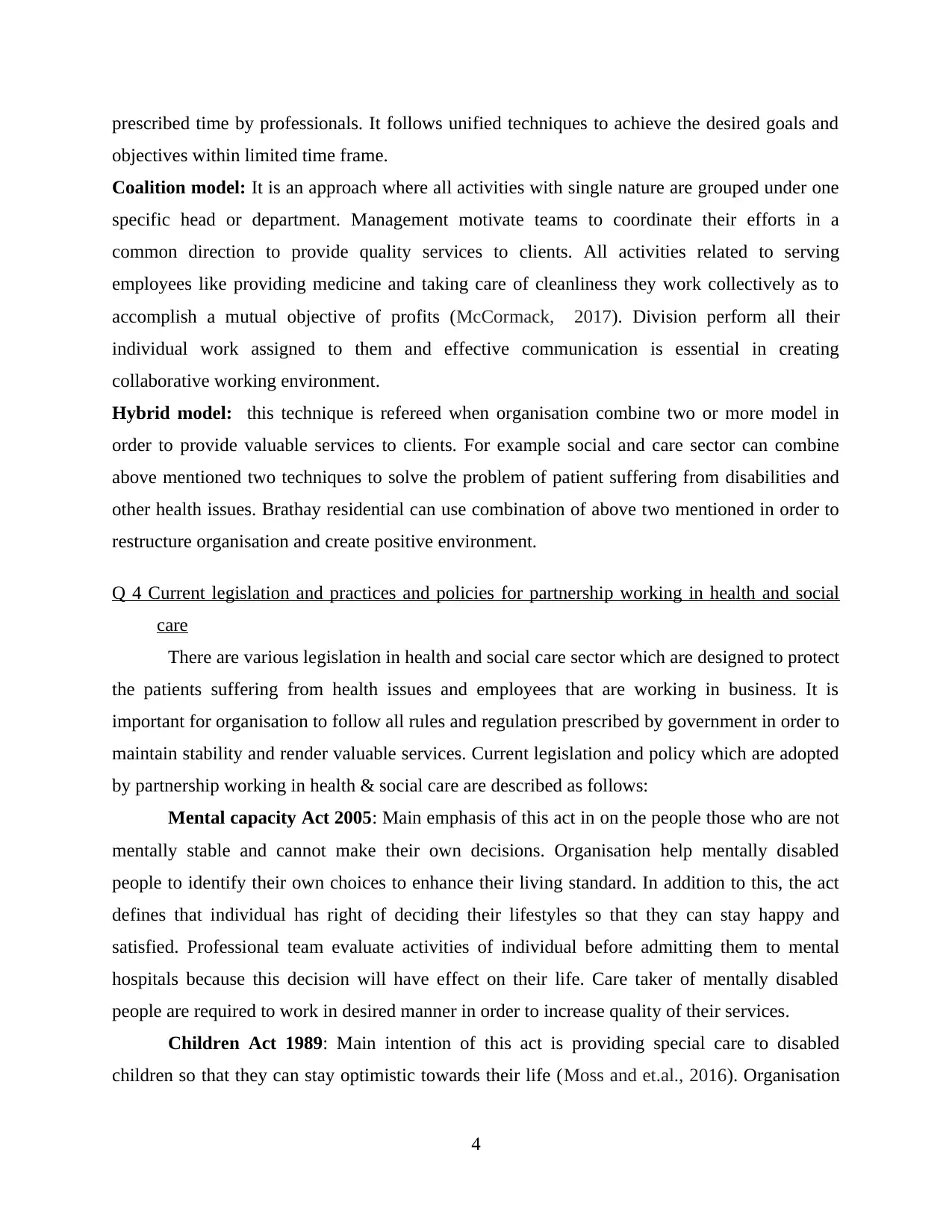
prescribed time by professionals. It follows unified techniques to achieve the desired goals and
objectives within limited time frame.
Coalition model: It is an approach where all activities with single nature are grouped under one
specific head or department. Management motivate teams to coordinate their efforts in a
common direction to provide quality services to clients. All activities related to serving
employees like providing medicine and taking care of cleanliness they work collectively as to
accomplish a mutual objective of profits (McCormack, 2017). Division perform all their
individual work assigned to them and effective communication is essential in creating
collaborative working environment.
Hybrid model: this technique is refereed when organisation combine two or more model in
order to provide valuable services to clients. For example social and care sector can combine
above mentioned two techniques to solve the problem of patient suffering from disabilities and
other health issues. Brathay residential can use combination of above two mentioned in order to
restructure organisation and create positive environment.
Q 4 Current legislation and practices and policies for partnership working in health and social
care
There are various legislation in health and social care sector which are designed to protect
the patients suffering from health issues and employees that are working in business. It is
important for organisation to follow all rules and regulation prescribed by government in order to
maintain stability and render valuable services. Current legislation and policy which are adopted
by partnership working in health & social care are described as follows:
Mental capacity Act 2005: Main emphasis of this act in on the people those who are not
mentally stable and cannot make their own decisions. Organisation help mentally disabled
people to identify their own choices to enhance their living standard. In addition to this, the act
defines that individual has right of deciding their lifestyles so that they can stay happy and
satisfied. Professional team evaluate activities of individual before admitting them to mental
hospitals because this decision will have effect on their life. Care taker of mentally disabled
people are required to work in desired manner in order to increase quality of their services.
Children Act 1989: Main intention of this act is providing special care to disabled
children so that they can stay optimistic towards their life (Moss and et.al., 2016). Organisation
4
objectives within limited time frame.
Coalition model: It is an approach where all activities with single nature are grouped under one
specific head or department. Management motivate teams to coordinate their efforts in a
common direction to provide quality services to clients. All activities related to serving
employees like providing medicine and taking care of cleanliness they work collectively as to
accomplish a mutual objective of profits (McCormack, 2017). Division perform all their
individual work assigned to them and effective communication is essential in creating
collaborative working environment.
Hybrid model: this technique is refereed when organisation combine two or more model in
order to provide valuable services to clients. For example social and care sector can combine
above mentioned two techniques to solve the problem of patient suffering from disabilities and
other health issues. Brathay residential can use combination of above two mentioned in order to
restructure organisation and create positive environment.
Q 4 Current legislation and practices and policies for partnership working in health and social
care
There are various legislation in health and social care sector which are designed to protect
the patients suffering from health issues and employees that are working in business. It is
important for organisation to follow all rules and regulation prescribed by government in order to
maintain stability and render valuable services. Current legislation and policy which are adopted
by partnership working in health & social care are described as follows:
Mental capacity Act 2005: Main emphasis of this act in on the people those who are not
mentally stable and cannot make their own decisions. Organisation help mentally disabled
people to identify their own choices to enhance their living standard. In addition to this, the act
defines that individual has right of deciding their lifestyles so that they can stay happy and
satisfied. Professional team evaluate activities of individual before admitting them to mental
hospitals because this decision will have effect on their life. Care taker of mentally disabled
people are required to work in desired manner in order to increase quality of their services.
Children Act 1989: Main intention of this act is providing special care to disabled
children so that they can stay optimistic towards their life (Moss and et.al., 2016). Organisation
4
⊘ This is a preview!⊘
Do you want full access?
Subscribe today to unlock all pages.

Trusted by 1+ million students worldwide
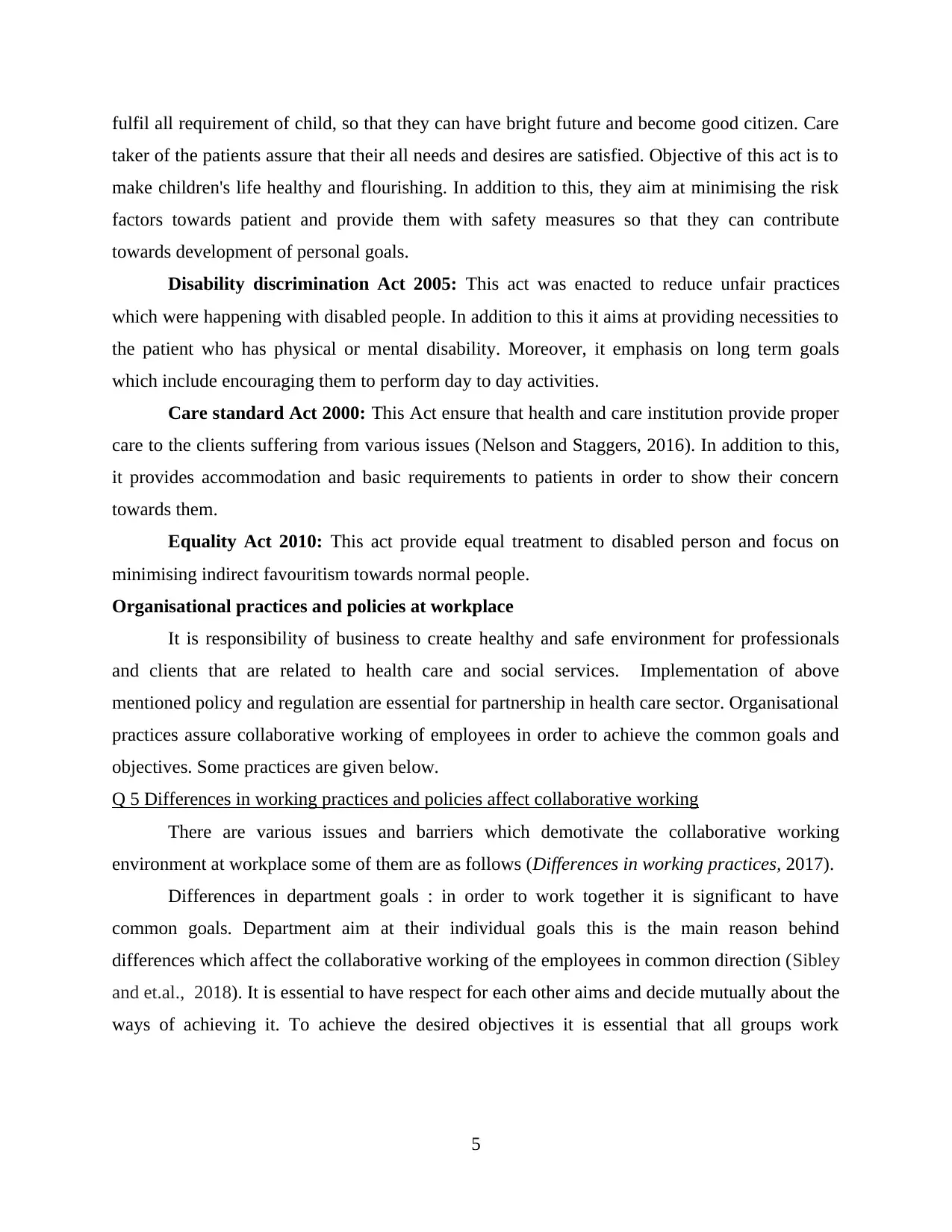
fulfil all requirement of child, so that they can have bright future and become good citizen. Care
taker of the patients assure that their all needs and desires are satisfied. Objective of this act is to
make children's life healthy and flourishing. In addition to this, they aim at minimising the risk
factors towards patient and provide them with safety measures so that they can contribute
towards development of personal goals.
Disability discrimination Act 2005: This act was enacted to reduce unfair practices
which were happening with disabled people. In addition to this it aims at providing necessities to
the patient who has physical or mental disability. Moreover, it emphasis on long term goals
which include encouraging them to perform day to day activities.
Care standard Act 2000: This Act ensure that health and care institution provide proper
care to the clients suffering from various issues (Nelson and Staggers, 2016). In addition to this,
it provides accommodation and basic requirements to patients in order to show their concern
towards them.
Equality Act 2010: This act provide equal treatment to disabled person and focus on
minimising indirect favouritism towards normal people.
Organisational practices and policies at workplace
It is responsibility of business to create healthy and safe environment for professionals
and clients that are related to health care and social services. Implementation of above
mentioned policy and regulation are essential for partnership in health care sector. Organisational
practices assure collaborative working of employees in order to achieve the common goals and
objectives. Some practices are given below.
Q 5 Differences in working practices and policies affect collaborative working
There are various issues and barriers which demotivate the collaborative working
environment at workplace some of them are as follows (Differences in working practices, 2017).
Differences in department goals : in order to work together it is significant to have
common goals. Department aim at their individual goals this is the main reason behind
differences which affect the collaborative working of the employees in common direction (Sibley
and et.al., 2018). It is essential to have respect for each other aims and decide mutually about the
ways of achieving it. To achieve the desired objectives it is essential that all groups work
5
taker of the patients assure that their all needs and desires are satisfied. Objective of this act is to
make children's life healthy and flourishing. In addition to this, they aim at minimising the risk
factors towards patient and provide them with safety measures so that they can contribute
towards development of personal goals.
Disability discrimination Act 2005: This act was enacted to reduce unfair practices
which were happening with disabled people. In addition to this it aims at providing necessities to
the patient who has physical or mental disability. Moreover, it emphasis on long term goals
which include encouraging them to perform day to day activities.
Care standard Act 2000: This Act ensure that health and care institution provide proper
care to the clients suffering from various issues (Nelson and Staggers, 2016). In addition to this,
it provides accommodation and basic requirements to patients in order to show their concern
towards them.
Equality Act 2010: This act provide equal treatment to disabled person and focus on
minimising indirect favouritism towards normal people.
Organisational practices and policies at workplace
It is responsibility of business to create healthy and safe environment for professionals
and clients that are related to health care and social services. Implementation of above
mentioned policy and regulation are essential for partnership in health care sector. Organisational
practices assure collaborative working of employees in order to achieve the common goals and
objectives. Some practices are given below.
Q 5 Differences in working practices and policies affect collaborative working
There are various issues and barriers which demotivate the collaborative working
environment at workplace some of them are as follows (Differences in working practices, 2017).
Differences in department goals : in order to work together it is significant to have
common goals. Department aim at their individual goals this is the main reason behind
differences which affect the collaborative working of the employees in common direction (Sibley
and et.al., 2018). It is essential to have respect for each other aims and decide mutually about the
ways of achieving it. To achieve the desired objectives it is essential that all groups work
5
Paraphrase This Document
Need a fresh take? Get an instant paraphrase of this document with our AI Paraphraser
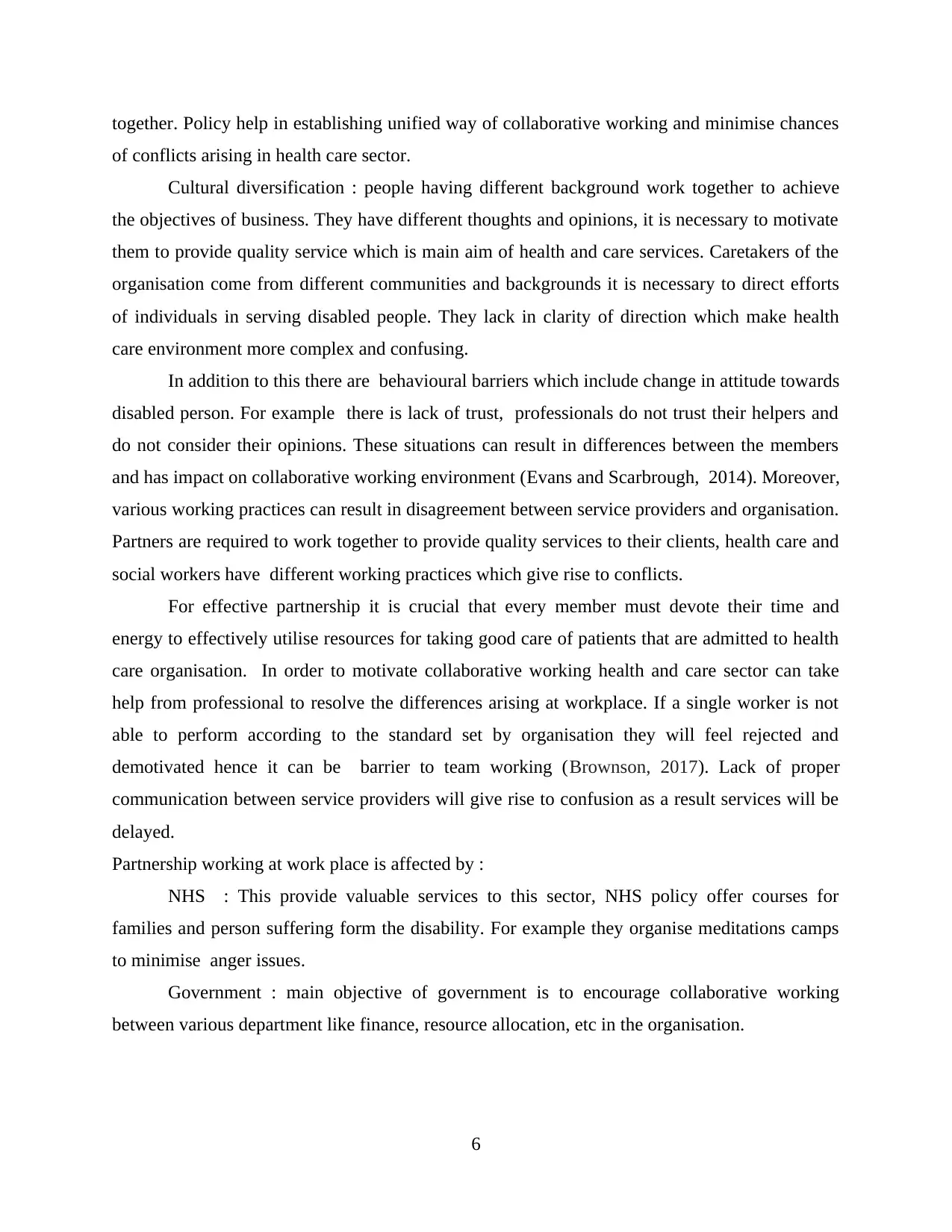
together. Policy help in establishing unified way of collaborative working and minimise chances
of conflicts arising in health care sector.
Cultural diversification : people having different background work together to achieve
the objectives of business. They have different thoughts and opinions, it is necessary to motivate
them to provide quality service which is main aim of health and care services. Caretakers of the
organisation come from different communities and backgrounds it is necessary to direct efforts
of individuals in serving disabled people. They lack in clarity of direction which make health
care environment more complex and confusing.
In addition to this there are behavioural barriers which include change in attitude towards
disabled person. For example there is lack of trust, professionals do not trust their helpers and
do not consider their opinions. These situations can result in differences between the members
and has impact on collaborative working environment (Evans and Scarbrough, 2014). Moreover,
various working practices can result in disagreement between service providers and organisation.
Partners are required to work together to provide quality services to their clients, health care and
social workers have different working practices which give rise to conflicts.
For effective partnership it is crucial that every member must devote their time and
energy to effectively utilise resources for taking good care of patients that are admitted to health
care organisation. In order to motivate collaborative working health and care sector can take
help from professional to resolve the differences arising at workplace. If a single worker is not
able to perform according to the standard set by organisation they will feel rejected and
demotivated hence it can be barrier to team working (Brownson, 2017). Lack of proper
communication between service providers will give rise to confusion as a result services will be
delayed.
Partnership working at work place is affected by :
NHS : This provide valuable services to this sector, NHS policy offer courses for
families and person suffering form the disability. For example they organise meditations camps
to minimise anger issues.
Government : main objective of government is to encourage collaborative working
between various department like finance, resource allocation, etc in the organisation.
6
of conflicts arising in health care sector.
Cultural diversification : people having different background work together to achieve
the objectives of business. They have different thoughts and opinions, it is necessary to motivate
them to provide quality service which is main aim of health and care services. Caretakers of the
organisation come from different communities and backgrounds it is necessary to direct efforts
of individuals in serving disabled people. They lack in clarity of direction which make health
care environment more complex and confusing.
In addition to this there are behavioural barriers which include change in attitude towards
disabled person. For example there is lack of trust, professionals do not trust their helpers and
do not consider their opinions. These situations can result in differences between the members
and has impact on collaborative working environment (Evans and Scarbrough, 2014). Moreover,
various working practices can result in disagreement between service providers and organisation.
Partners are required to work together to provide quality services to their clients, health care and
social workers have different working practices which give rise to conflicts.
For effective partnership it is crucial that every member must devote their time and
energy to effectively utilise resources for taking good care of patients that are admitted to health
care organisation. In order to motivate collaborative working health and care sector can take
help from professional to resolve the differences arising at workplace. If a single worker is not
able to perform according to the standard set by organisation they will feel rejected and
demotivated hence it can be barrier to team working (Brownson, 2017). Lack of proper
communication between service providers will give rise to confusion as a result services will be
delayed.
Partnership working at work place is affected by :
NHS : This provide valuable services to this sector, NHS policy offer courses for
families and person suffering form the disability. For example they organise meditations camps
to minimise anger issues.
Government : main objective of government is to encourage collaborative working
between various department like finance, resource allocation, etc in the organisation.
6
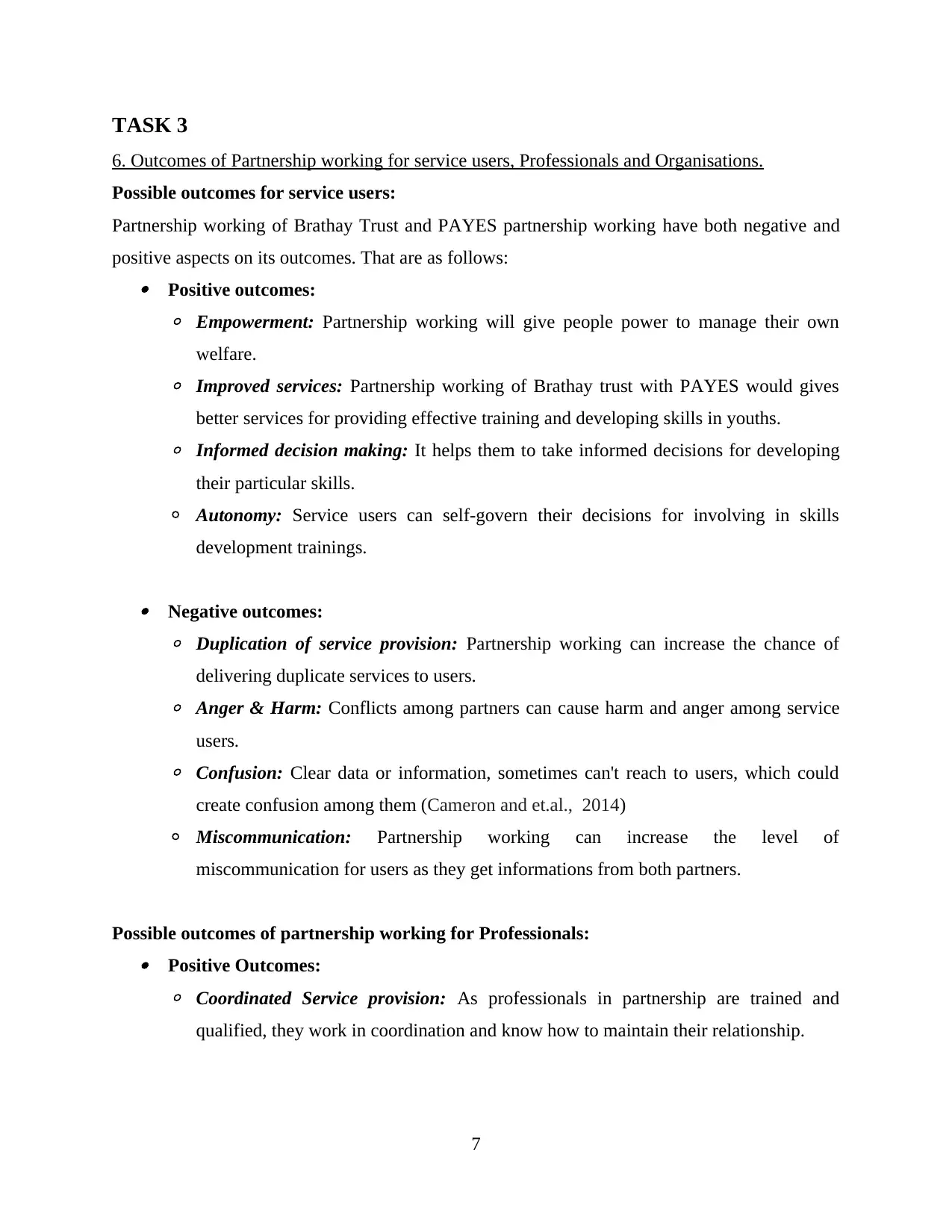
TASK 3
6. Outcomes of Partnership working for service users, Professionals and Organisations.
Possible outcomes for service users:
Partnership working of Brathay Trust and PAYES partnership working have both negative and
positive aspects on its outcomes. That are as follows: Positive outcomes:
◦ Empowerment: Partnership working will give people power to manage their own
welfare.
◦ Improved services: Partnership working of Brathay trust with PAYES would gives
better services for providing effective training and developing skills in youths.
◦ Informed decision making: It helps them to take informed decisions for developing
their particular skills.
◦ Autonomy: Service users can self-govern their decisions for involving in skills
development trainings.
Negative outcomes:
◦ Duplication of service provision: Partnership working can increase the chance of
delivering duplicate services to users.
◦ Anger & Harm: Conflicts among partners can cause harm and anger among service
users.
◦ Confusion: Clear data or information, sometimes can't reach to users, which could
create confusion among them (Cameron and et.al., 2014)
◦ Miscommunication: Partnership working can increase the level of
miscommunication for users as they get informations from both partners.
Possible outcomes of partnership working for Professionals: Positive Outcomes:
◦ Coordinated Service provision: As professionals in partnership are trained and
qualified, they work in coordination and know how to maintain their relationship.
7
6. Outcomes of Partnership working for service users, Professionals and Organisations.
Possible outcomes for service users:
Partnership working of Brathay Trust and PAYES partnership working have both negative and
positive aspects on its outcomes. That are as follows: Positive outcomes:
◦ Empowerment: Partnership working will give people power to manage their own
welfare.
◦ Improved services: Partnership working of Brathay trust with PAYES would gives
better services for providing effective training and developing skills in youths.
◦ Informed decision making: It helps them to take informed decisions for developing
their particular skills.
◦ Autonomy: Service users can self-govern their decisions for involving in skills
development trainings.
Negative outcomes:
◦ Duplication of service provision: Partnership working can increase the chance of
delivering duplicate services to users.
◦ Anger & Harm: Conflicts among partners can cause harm and anger among service
users.
◦ Confusion: Clear data or information, sometimes can't reach to users, which could
create confusion among them (Cameron and et.al., 2014)
◦ Miscommunication: Partnership working can increase the level of
miscommunication for users as they get informations from both partners.
Possible outcomes of partnership working for Professionals: Positive Outcomes:
◦ Coordinated Service provision: As professionals in partnership are trained and
qualified, they work in coordination and know how to maintain their relationship.
7
⊘ This is a preview!⊘
Do you want full access?
Subscribe today to unlock all pages.

Trusted by 1+ million students worldwide

◦ Professional approach: Partnership working for professionals creates professional
approaches for high standards of outcomes.
◦ Organised communication: Partnership to be successful there must be effective and
organised communication among professionals of Brathay trust and PAYES.
◦ Preventing mistakes: Through organised communication, professional approaches
and coordination, professionals can prevent mistakes or errors from occuring. Negative Outcomes:
◦ Professional rivalry: In both organisations employees may have different opinions or
thoughts, which would creates rivalry among professionals (Ellis, 2016).
◦ Time wasting: Partnership working is time wasting for professionals as, they have to
consider other partners for taking decisions.
◦ Miscommunication: Communication among partner organisations can be breakdown,
as it flows from different levels of Brathay trust and PAYES.
◦ Mismanagement of funds: Partnership working can cause mismanagement of funds
by professionals it their would be miscommunication and rivalry among them.
Possible outcomes for organisations: Positive outcome:
◦ Coherent approach: As two organisations comes together to function as partnership,
they would have a coherent approach for providing training and developing skills of
youths.
◦ Common working practices: Partnership working enables organisation to have a
common working practices for achieving their common goals or target.
◦ Shared Principles: Organisation have to follow shared common principles for better
functioning of partnership among Brathay trust and PAYES. Negative outcome:
◦ Communication breakdown: Brathay trust and PAYES have to effectively
communicate for success of partnership working (Glasby and Dickinson, 2014). Due
to different structures, communication among them breaks down.
8
approaches for high standards of outcomes.
◦ Organised communication: Partnership to be successful there must be effective and
organised communication among professionals of Brathay trust and PAYES.
◦ Preventing mistakes: Through organised communication, professional approaches
and coordination, professionals can prevent mistakes or errors from occuring. Negative Outcomes:
◦ Professional rivalry: In both organisations employees may have different opinions or
thoughts, which would creates rivalry among professionals (Ellis, 2016).
◦ Time wasting: Partnership working is time wasting for professionals as, they have to
consider other partners for taking decisions.
◦ Miscommunication: Communication among partner organisations can be breakdown,
as it flows from different levels of Brathay trust and PAYES.
◦ Mismanagement of funds: Partnership working can cause mismanagement of funds
by professionals it their would be miscommunication and rivalry among them.
Possible outcomes for organisations: Positive outcome:
◦ Coherent approach: As two organisations comes together to function as partnership,
they would have a coherent approach for providing training and developing skills of
youths.
◦ Common working practices: Partnership working enables organisation to have a
common working practices for achieving their common goals or target.
◦ Shared Principles: Organisation have to follow shared common principles for better
functioning of partnership among Brathay trust and PAYES. Negative outcome:
◦ Communication breakdown: Brathay trust and PAYES have to effectively
communicate for success of partnership working (Glasby and Dickinson, 2014). Due
to different structures, communication among them breaks down.
8
Paraphrase This Document
Need a fresh take? Get an instant paraphrase of this document with our AI Paraphraser
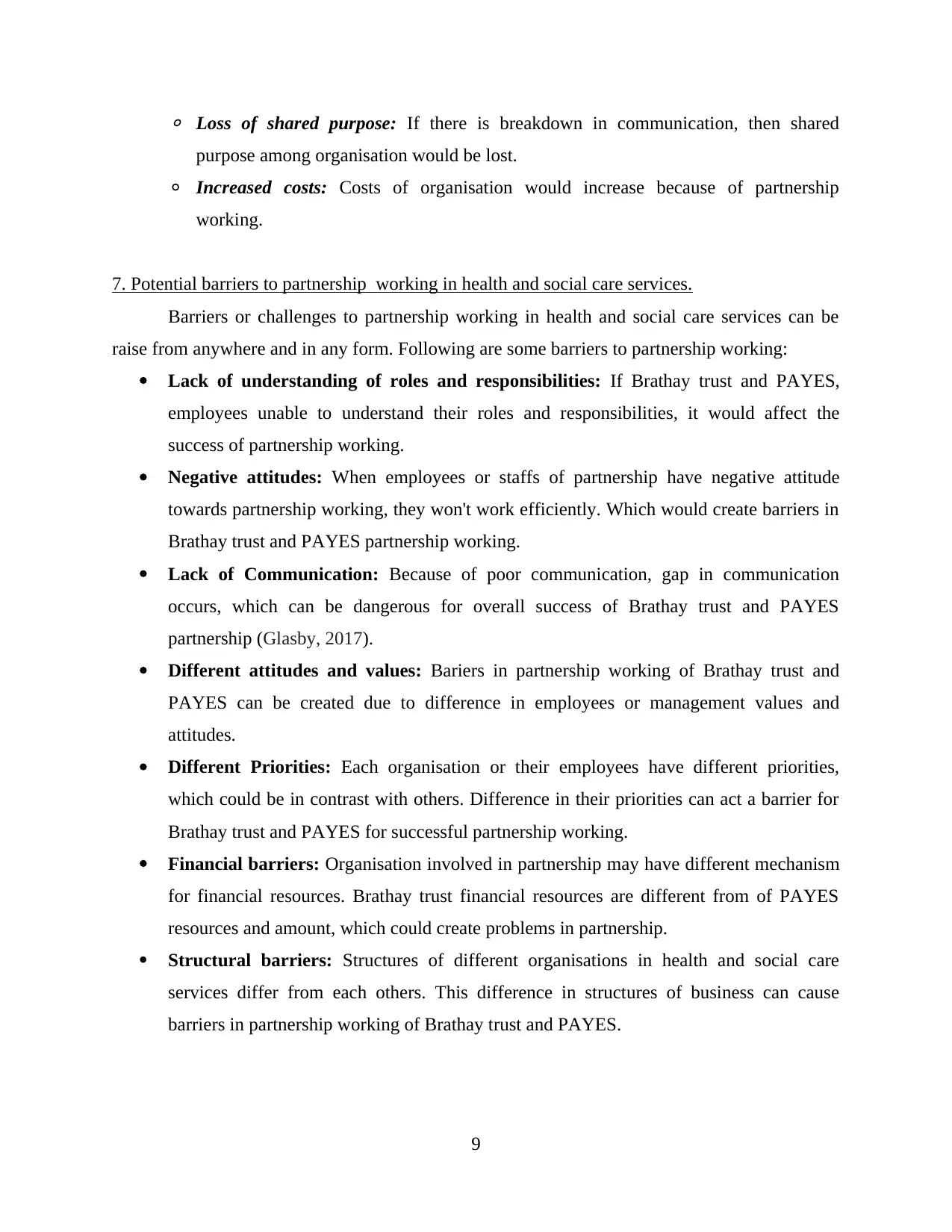
◦ Loss of shared purpose: If there is breakdown in communication, then shared
purpose among organisation would be lost.
◦ Increased costs: Costs of organisation would increase because of partnership
working.
7. Potential barriers to partnership working in health and social care services.
Barriers or challenges to partnership working in health and social care services can be
raise from anywhere and in any form. Following are some barriers to partnership working:
Lack of understanding of roles and responsibilities: If Brathay trust and PAYES,
employees unable to understand their roles and responsibilities, it would affect the
success of partnership working.
Negative attitudes: When employees or staffs of partnership have negative attitude
towards partnership working, they won't work efficiently. Which would create barriers in
Brathay trust and PAYES partnership working.
Lack of Communication: Because of poor communication, gap in communication
occurs, which can be dangerous for overall success of Brathay trust and PAYES
partnership (Glasby, 2017).
Different attitudes and values: Bariers in partnership working of Brathay trust and
PAYES can be created due to difference in employees or management values and
attitudes.
Different Priorities: Each organisation or their employees have different priorities,
which could be in contrast with others. Difference in their priorities can act a barrier for
Brathay trust and PAYES for successful partnership working.
Financial barriers: Organisation involved in partnership may have different mechanism
for financial resources. Brathay trust financial resources are different from of PAYES
resources and amount, which could create problems in partnership.
Structural barriers: Structures of different organisations in health and social care
services differ from each others. This difference in structures of business can cause
barriers in partnership working of Brathay trust and PAYES.
9
purpose among organisation would be lost.
◦ Increased costs: Costs of organisation would increase because of partnership
working.
7. Potential barriers to partnership working in health and social care services.
Barriers or challenges to partnership working in health and social care services can be
raise from anywhere and in any form. Following are some barriers to partnership working:
Lack of understanding of roles and responsibilities: If Brathay trust and PAYES,
employees unable to understand their roles and responsibilities, it would affect the
success of partnership working.
Negative attitudes: When employees or staffs of partnership have negative attitude
towards partnership working, they won't work efficiently. Which would create barriers in
Brathay trust and PAYES partnership working.
Lack of Communication: Because of poor communication, gap in communication
occurs, which can be dangerous for overall success of Brathay trust and PAYES
partnership (Glasby, 2017).
Different attitudes and values: Bariers in partnership working of Brathay trust and
PAYES can be created due to difference in employees or management values and
attitudes.
Different Priorities: Each organisation or their employees have different priorities,
which could be in contrast with others. Difference in their priorities can act a barrier for
Brathay trust and PAYES for successful partnership working.
Financial barriers: Organisation involved in partnership may have different mechanism
for financial resources. Brathay trust financial resources are different from of PAYES
resources and amount, which could create problems in partnership.
Structural barriers: Structures of different organisations in health and social care
services differ from each others. This difference in structures of business can cause
barriers in partnership working of Brathay trust and PAYES.
9
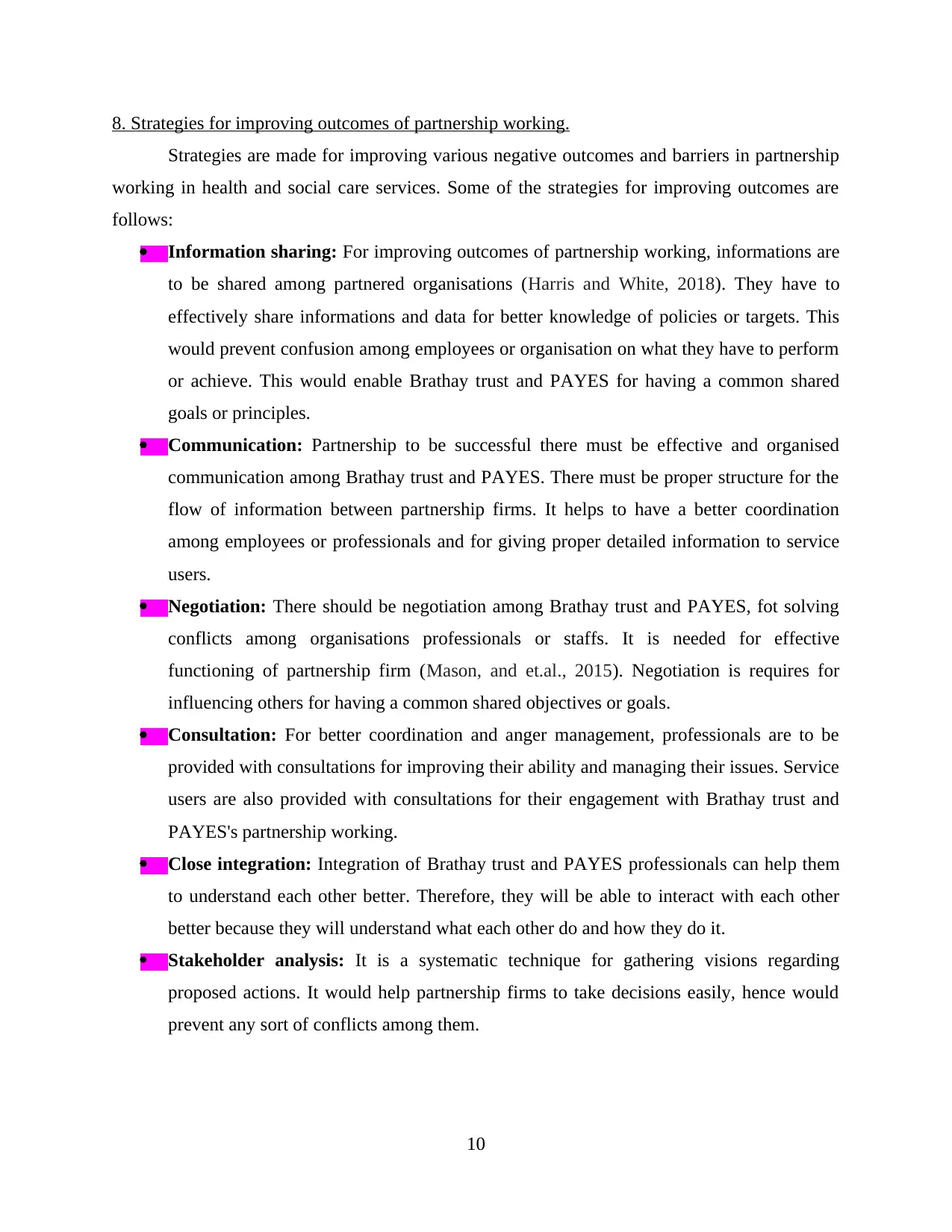
8. Strategies for improving outcomes of partnership working.
Strategies are made for improving various negative outcomes and barriers in partnership
working in health and social care services. Some of the strategies for improving outcomes are
follows:
Information sharing: For improving outcomes of partnership working, informations are
to be shared among partnered organisations (Harris and White, 2018). They have to
effectively share informations and data for better knowledge of policies or targets. This
would prevent confusion among employees or organisation on what they have to perform
or achieve. This would enable Brathay trust and PAYES for having a common shared
goals or principles.
Communication: Partnership to be successful there must be effective and organised
communication among Brathay trust and PAYES. There must be proper structure for the
flow of information between partnership firms. It helps to have a better coordination
among employees or professionals and for giving proper detailed information to service
users.
Negotiation: There should be negotiation among Brathay trust and PAYES, fot solving
conflicts among organisations professionals or staffs. It is needed for effective
functioning of partnership firm (Mason, and et.al., 2015). Negotiation is requires for
influencing others for having a common shared objectives or goals.
Consultation: For better coordination and anger management, professionals are to be
provided with consultations for improving their ability and managing their issues. Service
users are also provided with consultations for their engagement with Brathay trust and
PAYES's partnership working.
Close integration: Integration of Brathay trust and PAYES professionals can help them
to understand each other better. Therefore, they will be able to interact with each other
better because they will understand what each other do and how they do it.
Stakeholder analysis: It is a systematic technique for gathering visions regarding
proposed actions. It would help partnership firms to take decisions easily, hence would
prevent any sort of conflicts among them.
10
Strategies are made for improving various negative outcomes and barriers in partnership
working in health and social care services. Some of the strategies for improving outcomes are
follows:
Information sharing: For improving outcomes of partnership working, informations are
to be shared among partnered organisations (Harris and White, 2018). They have to
effectively share informations and data for better knowledge of policies or targets. This
would prevent confusion among employees or organisation on what they have to perform
or achieve. This would enable Brathay trust and PAYES for having a common shared
goals or principles.
Communication: Partnership to be successful there must be effective and organised
communication among Brathay trust and PAYES. There must be proper structure for the
flow of information between partnership firms. It helps to have a better coordination
among employees or professionals and for giving proper detailed information to service
users.
Negotiation: There should be negotiation among Brathay trust and PAYES, fot solving
conflicts among organisations professionals or staffs. It is needed for effective
functioning of partnership firm (Mason, and et.al., 2015). Negotiation is requires for
influencing others for having a common shared objectives or goals.
Consultation: For better coordination and anger management, professionals are to be
provided with consultations for improving their ability and managing their issues. Service
users are also provided with consultations for their engagement with Brathay trust and
PAYES's partnership working.
Close integration: Integration of Brathay trust and PAYES professionals can help them
to understand each other better. Therefore, they will be able to interact with each other
better because they will understand what each other do and how they do it.
Stakeholder analysis: It is a systematic technique for gathering visions regarding
proposed actions. It would help partnership firms to take decisions easily, hence would
prevent any sort of conflicts among them.
10
⊘ This is a preview!⊘
Do you want full access?
Subscribe today to unlock all pages.

Trusted by 1+ million students worldwide
1 out of 15
Related Documents
Your All-in-One AI-Powered Toolkit for Academic Success.
+13062052269
info@desklib.com
Available 24*7 on WhatsApp / Email
![[object Object]](/_next/static/media/star-bottom.7253800d.svg)
Unlock your academic potential
Copyright © 2020–2025 A2Z Services. All Rights Reserved. Developed and managed by ZUCOL.





